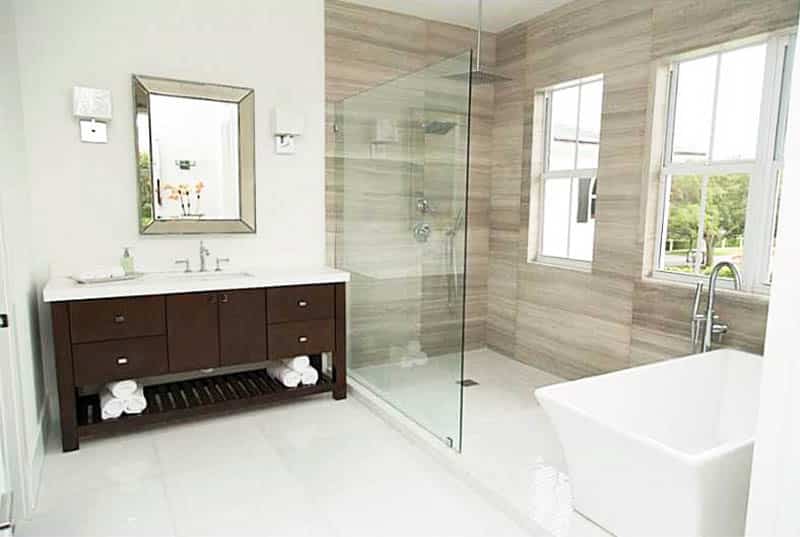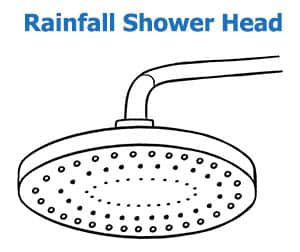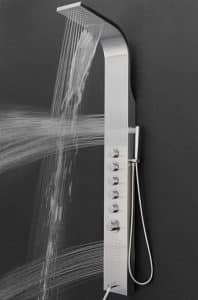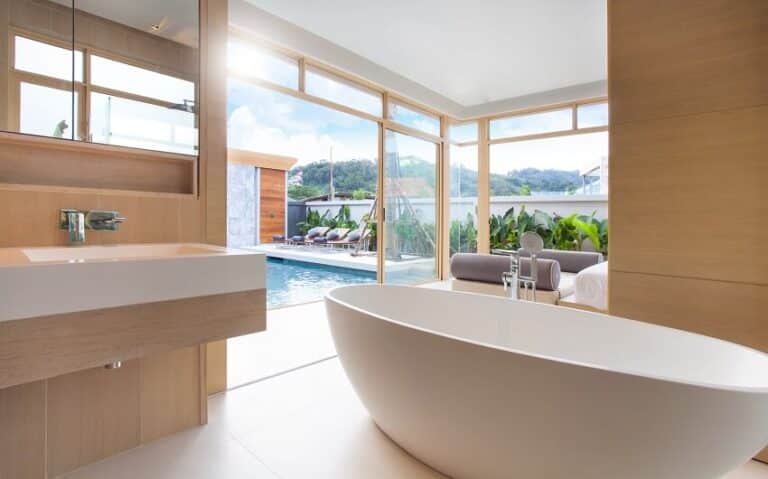25 Types of Bathroom Showers With Different Materials & Designs

Your shower is an essential part of your bathroom. After a long, hard day out of your home – be it for work or play – there is nothing better than stepping in and letting the water wash your worries, cares, and the sweat of the day’s activities away. The type of bathroom shower you choose will help you create the relaxing atmosphere you want from your ideal bathroom. You want a bathing area that you can relax and be comfortable in. Your bathroom should be a place of relaxing contemplation as a place that enhances the look of your home.
When choosing between the types of bathroom showers, you need to consider the different styles and designs. You can choose between custom spaces and prefabricated enclosures. You will also have a choice of different shapes and even types of door operations and enclosures. The type you choose should fit the all-around design of your bathroom and also fit your particular needs.
Shower Types By Design
There are many different types of bathroom showers out there, and it might be a little confusing as to which exactly is the right one for you. To help you make the best decision, we’ve identified important questions you need to ask yourself and why they are important. Follow along and make the best decision on what type of bathroom shower is YOUR dream come true.
Walk-In Showers – Contemporary And Attractive
Walk-in showers have revolutionized contemporary bathroom design with their sleek look and practical open layout. Stepping into one of these elegant installations feels like entering a luxurious spa. Gone are the days of climbing over a tub edge or awkwardly shuffling through a narrow shower entrance. Walk-in showers feature barrier-free access and enough interior space to truly relax. Let’s explore what makes them so attractive:
The highlight of many of these designs is an entrance with zero threshold – no trim or lip to traverse. This creates a smooth floor plane from bathroom to shower for easy mobility. Strategic slopes and drains prevent water from flooding the space while remaining undetectable underfoot.
There are several glass panel configurations to choose depending on your floor plan layout and preferences. Full-height glass partitions make a dramatic style statement, while partial panels enhance ventilation. Single glass walls effectively limit splashes, or multiple panels can fully enclose the area when desired.
Accessibility options make these types highly configurable depending on different needs. Built-in benches, grab bars, adjustable shower heads, non-slip floors and ample maneuvering room allow users of all abilities to enjoy these modern spaces. The ability to add high-end details adds to their customization. Large-format tiles, frameless glass dividers, curbless transitions and designer drains contribute sleek visual appeal. Discreet shelving keeps necessities handy without clutter.
To ensure proper functionality a minimum size of 36 x 36 inches works for basic needs, but 42 x 60 inches provides a true spa experience. Allowing for storage, fixtures and clear entry access are also key design aspects to consider.
Corner Showers: Space Saving with Style
Looking to add a shower to your bathroom but don’t have much space? Corner showers are a stylish and smart solution! By tucking neatly into any bathroom corner, these angled wonders free up floor space for other fixtures while still offering a roomy washing area.
The key benefit is optimization. Corner showers maximize every inch by using two intersecting walls as their footprint. This strategic placement leaves more room in small bathrooms for sinks, toilets and cabinets. It also creates better flow for getting in and out. The diagonal entrance makes the whole bathroom feel more spacious and airy.
Now for the fun part – choosing a design! The two main options are neo-angle and quarter-round styles. Neo-angle showers have a modern, geometric shape with three glass walls that meet at angles. This provides a roomy interior without requiring much floor space. You’ll need about 3-3 1/2 feet of wall length on two adjoining sides. Quarter-round designs have a more curved front with one rounded panel. This gives a soft, fluid look that fits snugly into tightest corners, needing as little as 2 1/2-3 feet of wall space.
When it comes to materials, today’s corner showers offer sleek glass panels, easy-clean fiberglass or acrylic, even natural stone. Frameless glass gives a contemporary, elegant vibe. Frosted or textured glass ensures privacy. Chrome, bronze or nickel trim coordinates with other hardware. Doors range from pivoting panels that swing outward for wide access to sliding doors for a more streamlined look. Some quarter-round models have rounded doors to match the curves. Walk-in models without doors work in bigger bathrooms.
Tub-Shower Combinations: Versatile And Practical
Tub-shower combos are hugely popular these days, merging the best features of both bathtubs and showers into one practical fixture. With space at a premium in many homes, it’s a versatile way to allow for a relaxing soak or a quick rinse without requiring separate installations.
As the name implies, you combine two bathroom features: the tub and the showering space. This popular combo maximizes space and is installed over a bathtub, so the tub is the base, and you must step in to bathe. Combining a tub and shower in your bathroom is a practical, space-saving trick.
That’s why this particular type of semi-enclosure is popular in hotels. It also allows you to have some variety in your bathroom routine as you now have two ways to wash away the day’s cares. However, there’s no denying that many of these combos are not very attractive, especially when they use cheaper materials and fixtures. Think before you decide on this enclosure.
When it comes to tubs, you’ve got options ranging from standard 60×30-inch models to expanded deep-soaking tubs. The standard size fits most bathrooms and budgets, while the deeper tubs provide extra room to unwind. Materials run the gamut from acrylic to enameled steel. Just bear in mind the deeper the tub, the more reinforcement it needs for all that water weight!
Now for the shower component. A basic shower curtain offers affordable convenience, while frameless glass doors provide sleek modern style. Both have tradeoffs in ease of access and water splashing. Storage-wise, built-in recessed niches eliminate the need for external shelving without squeezing floor space.
Safety is also key, with textured tub bottoms, rounded corners, grab bars and adjustable shower heads to prevent slips and falls, especially with little ones. Temperature regulating features add extra precaution too.
When it comes to design, contemporary styles favor clean lines, neutral tones and built-in lighting. Traditional motifs incorporate vintage-inspired hardware, subway tile and decorative shower curtains. Modern farmhouse elements like shiplap-look surrounds, industrial fixtures and black and white patterns blend old and new.
Frameless Showers: Modern Elegance
Frameless showers are the epitome of modern elegance in bathroom design. Doing away with bulky metal frames allows the glass itself to shine as the star of the show, creating an airy, open look and feel. The clean sightlines and seamless corners give off an impression of luxury while letting your eyes travel uninterrupted across the space.
The minimalist hardware choices, like discreet hinges and handles, keep focus on the glass rather than the mechanics. This transparency and openness works great in contemporary styled bathrooms, complementing the simpler lines and less cluttered aesthetics. Plus, the floating glass partition between shower and room lends a lighter, airier mood.
Gone are the days of dated shower doors and liners. Frameless uses ultra-clear tempered safety glass, polished to resplendent perfection. For those desiring more privacy, acid-etched glass offers obscure patterns while allowing light to filter through. The varieties of glass capabilities available nowadays really opens up design options.
Make no mistake though – frameless showers require meticulous design and installation to ensure waterproofing and structural soundness. The walls need to be near perfectly plumb and blocking installed exactly right to support the mounted glass panels. It’s crucial to integrate top-notch water barrier systems behind finish tilework too. Though they appear suspended in air, impeccable engineering keeps these luxurious stunners safely and reliably in place.
Shower Types by Functionality
Now we’ll describe popular styles based on their functionality to help you determine your needs.
Rain Showers: Creating a Luxurious Shower Experience
Looking to upgrade your regular old shower? Enter: the rain shower. Rain showers were built to provide a gentle, natural rainfall, that allows cascading water to fall on you. It’s like standing out in a spring shower, but hotter and indoors.
Ceiling-Mounted Options
When it comes to installation, rain showers offer lots of options to match your bathroom’s style. Most people go for the full luxury effect with an overhead, ceiling-mounted rain shower. This looks gorgeous and really makes you feel immersed under a rain cloud. Many ceiling-mounted models have a flush profile that seamlessly blends into the ceiling.
You can also find suspended rain shower heads that hang elegantly from the ceiling on a decorative drop-down pipe. Another sleek, subtle look is to recess these fixtures right into the ceiling. Beyond overhead mounting, you’ll also find sizes ranging from 8 inches to a huge 24-inch diameter. Some even have integrated LED lighting for a chromotherapy effect.
Wall-Mounted Options
Transform your shower into a rejuvenating oasis with luxurious rain shower systems. Wall-mounted configurations open up a world of customization for your perfect shower experience. Extendable arm mounts position the shower head for optimal spray coverage while adjustable angle brackets let you direct the water flow exactly where you want it.
Combination units incorporate convenient handheld sprayers for targeted rinses and intricate detailing. Swivel adapters add flexibility to angle the shower precisely. Slim space-saving designs blend seamlessly into your bathroom’s sophisticated aesthetics with designer finishes to match your fixtures and hardware.
Steam Showers: The Ultimate Home Spa Experience
Beyond your typical shower experience, a steam shower uses moist, warm steam to envelop you. A proper steam shower requires converting part of your bathroom into a sealed, vapor-tight enclosure. That means installing floor-to-ceiling waterproof walls with a sloped ceiling to prevent drips. The door should seal tightly with gaskets and sweeps along the bottom. Glass, tile or stone surfaces work best. Every joint and corner needs to be completely siliconed to contain the steam. With the right waterproof bench seating included, you’ll have a relaxing retreat!
The steam itself comes from a generator sized for the cubic footage of your shower space. These specialized units require dedicated power and water lines to heat up and transform water into surrounding steam. Top-end generators feature quiet operation, auto-flushing and all the necessary safety valves.
Now to the best part – the benefits! Taking a steam shower has numerous research-backed health advantages. The warm moisture is great for respiratory issues, breaking up sinus congestion, and opening airways. Your muscles unwind, circulation improves, and your whole body goes into a relaxed state. The hydration and heat are also good for your skin. Beyond the physical perks, steam showers simply help melt away stress and give your mind a chance to recharge.
Power Showers: Enhanced Experience With Advanced Pressure Systems
Power showers use internal pump systems to give you an awesome high-pressure water flow, even with low water pressure in your home. The key is the electric pump mechanism that kicks water pressure up to 10-16 liters per minute. These pumps sense and automatically adjust pressure, providing a consistent and customized shower experience.
You can choose between single or twin pump models depending on your needs. The pumps are precision-engineered for performance, quiet operation, and longevity. Anti-vibration mounts prevent noise and movement for smooth sailing.
And we can’t forget about all the features that make power showers so great: multiple spray patterns from a gentle rain to a massage jet, air injection for a luxurious soak, anti-scale tech to prevent mineral buildup, and water-saving modes to conserve H2O. There are even adjustable flow restrictors to find your perfect pressure and temp.
Now for the downside – these high-powered systems use extra electricity. Plan for 200-500 watt power consumption to run the pump. Higher pressure equals higher energy use. But efficient thermostatic controls, automatic shut-off timers, and heat retention can offset costs.
Body Spray Showers: For A Personal Hydrotherapy Experience
Body spray showers offer a totally customizable hydrotherapy experience that will make your bathroom feel like a spa retreat. These showers go way beyond normal with strategically-placed water jets to pamper your body top to bottom.
You can direct the massage jets at just upper body areas to relieve those sore shoulder muscles. Configure lower mid-body sprays to soothe tired legs and feet. Or create water sequences flowing from side to side to cover you completely. With options for pulsing, wide coverage and ultra focused streams, not to mention temperature and pressure controls, body spray showers let you tailor and adjust to your heart’s content each time you bathe.
The jets themselves need good water flow – we’re talking a dedicated line supplying each spray head with 2.5 gallons per minute at 45+ PSI. These specialized showers have built-in valves and anti-scald regulators so you can zone in on muscle groups safely. Mount the jets in opposite vertical rows, spaced at least 6 inches apart, to blanket yourself effectively.
Shower Designs by Installation
These designs feature specific installation styles that will be determined by your needs, room’s size and layout.
Prefabricated Showers: Combining Convenience with Quality
A prefabricated unit comes already made. It usually comes as a single piece you can install in your space. These units have all the necessary parts included in one piece. This includes the walls, floors, and doors, and – depending on the unit you choose, a variety of finishes and accessories.

Prefabricated showers offer a convenient, quality bathroom solution. These factory-built units combine durability with easy installation, providing practical options to suit different needs and budgets. One-piece seamless models feature built-in shelves, textured floors for slip resistance, and reinforced walls for grab bars. Sectional designs in 3-5 interlocking panels make transport through doorways and adjustment easier.
Both acrylic and fiberglass materials have advantages. Acrylic offers scratch resistance, color-fastness, and superior heat retention. Fiberglass provides good impact resistance, lightweight handling, and more affordable repairs.
Installation typically takes 4-8 hours. Requirements include proper site prep, plumbing rough-ins, level floor, wall alignment, bracing techniques, sealing, and final fixture hooks-ups. Units range $300-$2000 with installation costs from $500-$1500. Savings come from lower labor and maintenance plus potential DIY installs. Warranties, reduced repairs, easy cleaning, and minimal upkeep provide long-term value.
Standard Prefab Shower Sizes
Standard sizes fit common layouts, like 32” corner models up to 60” tub replacements. Contemporary to traditional looks offer custom colors and barrier-free accessibility.
- 32″ x 32″ corner units
- 36″ x 36″ square designs
- 36″ x 48″ rectangular options
- 48″ x 36″ reverse configurations
- 60″ x 30″ tub replacement size
As a prefabricated shower already comes with most everything you need, all you need to do is pick the unit that suits your tastes and needs and install the whole thing in one go. This saves you a lot of time, with the trade-off being the lack of all the personalized features you may want.
There are also many prefabricated products available out there with various features that you can choose from. If you take your time and pick carefully, you will find one that can suit your needs and match your bathroom’s style and theme. This is the more budget-friendly option.
Custom Showers: Creating Your Perfect Personal Oasis
Creating your dream custom shower is all about crafting a personal oasis tailored exactly to your style, needs and preferences. With endless design possibilities, you can combine aesthetics and functionality to build your perfect sanctuary.
When selecting materials, choose those that speak to your personal tastes – whether you love the refined elegance of marble, the contemporary edge of large-format porcelain tiles or the natural warmth of travertine. Consider texture and visual interest too. Slate offers wonderful variation while glass mosaic accents add a touch of dazzle and drama.
In terms of layout, let your imagination run free! Opt for an expansive walk-in configuration with multiple entry points or go for clean, simple lines. Curve the walls or keep them straight. Build in extra special features like seating areas to pamper yourself or recessed niches to store bathing essentials. You might even include distinct showering zones for different needs.
Now comes the best part – customizing fixtures and accessories! Place showerheads strategically for your ideal experience. Integrate water features like invigorating body sprays or tranquil waterfalls. Infuse chromotherapy mood lighting. Install handheld shower units for targeted massages. Further personalize with storage solutions like corner shelving, floating product holders or hidden compartments to neatly tuck away all your items.
Luxury Features
Integrate the latest smart home technology and luxury features to create a truly customized hydrotherapy experience right in your bathroom. An advanced digital control panel makes it easy to set your perfect temperature and activate different zones of body sprays, rain showerheads, hand showers, and more all with the tap of a finger. Select a relaxing melody from the built-in Bluetooth speakers, adjust colors and brightness with LED lighting, and even ask your voice assistant to start the steam.
Pamper your feet with heated floors that feel refreshing even on chilly mornings. Never deal with foggy mirrors after a hot soak thanks to defoggers that sense and clear the moisture. Built-in dispensers fill the space with your preferred essential oils infusing each breath and steamy inhalation with soothing scents.
Beyond digital add-ons, customize the shower space itself with textured designer floor and wall tiles, vibrant patterned glass accents, drain covers that double as art, and posh hardware in finishes from polished chrome to matte black and more.
The first question to ask before you proceed is, do I want to have a custom design, or will a prefabricated enclosure for showering do? A custom shower will be built from scratch according to your exact specifications. This means that every component – from the sprayer to the flooring – will be picked out by you. Custom showers are uniquely suited to your personal preferences.
Popular custom design features include:
- Rainfall heads
- Dual heads
- Bench seat
- LED lighting
- Digital temperature controls
- Built-in sound
- Steam enclosure
- Handheld sprayers
- High pressure
By choosing a custom enclosure, you can be sure that your design fits your space, needs, and idea of what your dream bathroom will look like. However, as a custom project is built from scratch, it can be complicated, time-consuming, and quite expensive.
Wet Rooms: The Ultimate Open-Concept Bathroom Solution
By transforming the entire space into a seamless shower enclosure, wet rooms provide unmatched accessibility and style. However, creating this sophisticated look requires careful attention to waterproofing details and drainage.
The flooring choice is crucial. A robust tanking system must be installed first, with reinforced membranes, corner treatments, joint seals, and perimeter waterproofing. This shields the substrate while allowing for drainage. The floor surface itself calls for non-slip, moisture-resistant materials like tile with proper grout. An easy-clean finish facilitates maintenance. Walls also need comprehensive moisture protection. Floor-to-ceiling vapor barriers, liquid waterproofing layers, and crack sealing defend against leaks. Window and door frames warrant special detailing to keep up with the constant moisture.
Linear drains provide efficient water evacuation. Positioned near walls and under key areas, they come in various load-bearing sizes. Custom drainage channels may also be formed into the floor slope. A minimum 1:50 gradient prevents standing water. Ventilation regulates humidity and condensation. High-powered fans, strategically placed windows, or cross ventilation keeps the air fresh.
Enclosed Wet Room
A wet room design like this combines a bathtub in the same enclosure as the wash area. This design has the benefit of keeping water spills primarily in one part of the room’s layout. The downside to this is more maintenance, as moisture from the area tends to fall all over the tub, even when it’s not used, creating more potential cleaning.
Shower Shapes
What type of bathroom enclosure shape should you install? When crafting a unique and relaxing spa-like experience, we can’t neglect the aesthetic and practical importance of choosing the right shape. The right shape can make or break your entire bathroom, as a stall that doesn’t “fit” can ruin your space’s overall theme and look.
The shape of your stall depends on the shape of your enclosure. Your basic enclosure includes the walls and floor. Simply put, it is where you stand to take your bath. According to the shape of the stall, there are five basic types of bathroom enclosure shapes that you can choose from:
Rectangular or Square Enclosure

This is the most basic shape that an enclosure can come in. Just like the name says, it is composed of four sides that enclose a rectangular or square space. The reason for the popularity of the rectangular or square enclosure is its versatility. An enclosure in this shape can fit almost any bathroom area and suit almost any room’s design style. You can find many prefabricated enclosures in this shape in almost any size.
With regards to your bathing experience, a rectangular enclosure provides ample room for your cleaning & rinsing activities so it’s a good choice that will work with almost any sprayer or faucet system.
Corner Enclosure

This is a particularly good shape to have if you have limited space. This type of stall is designed to fit in the corner of your bathroom. Many corner enclosure showers come in a rectangular, angled, or square shape, but they many also be curved. (See more information previously mentioned above.)
Curved Shower

The curved enclosure basically has three sides to the rectangular enclosure’s four. Like the corner enclosure, it is also built to fit into the corner of your bathroom area. Also known as a quadrant enclosure, the curved wall design encloses an area in the shape of a pizza slice.
Two straight walls form an angle while the third wall, often the entrance or door, bridges that angle, but in the corner enclosure, it is a curved line. The curve of the third wall creates more space than a plain, straight line would.
Round Shower
As its name implies, the round enclosure is shaped like a circle. While it can make an interesting bathroom feature, you’ll need a lot of space if you incorporate this round shape into your bathroom design. It is a free-standing circular shape, meaning it will not use the corners of your room and must be placed in the middle.
Neo Angle Shower
Rather than use walls that have 90° corners, a neo-angle design has walls that feature 135° angles, and most have a shortened 45° outer corner. This space-saving modern design adds interesting visual flair to the space and can be modified to the layout of the bathroom floorplan. The average size of a neo-angled design is 36″ by 36″; however, many different models exist.
The primary advantage of this design is that its minimal construction provides little room for mold and mildew to accumulate and thus makes cleaning and maintenance easier to perform.
Most neo-angle showers are sold as all-in-one-packages. The kit includes the pan, three wall pieces (two flat panel and a corner shelf connector unit), and the glass panels and frames for the door. – Chris Peterson, Black and Decker The Complete Guide to Bathrooms Updated 6th Edition
Manual Mixer Shower
This is the most basic showerhead system that most people are used to finding in a bathroom. A mixer unit takes its name from the water temperature, allowing you to mix hot and cold water to get the desired temperature. The basic part of a mixer design is the head and one or two valves.
By turning the valves, you can control how much cold or hot water comes out of the showerhead. This allows you to control the overall temperature of your water. These types of systems are common and popular because they are easy to use and also easy – and economical – to install.
 Thermostatic Shower
Thermostatic Shower
As with a manual mixer system, the defining feature of a thermostatic showering system is that it allows you to control the water temperature from your fixture.
The difference is instead of manually controlling the temperature by manipulating the valve, you program your ideal water temperature into a built-in thermostat. This ensures that your faucet system automatically provides a consistent water temperature.
Many thermostatic systems incorporate a digital control panel. When they do, these systems can also be called digital showers.
The advantage of this type is the consistency of the water temperature. With this device, there is no more standing to the side shivering or accidentally scalding yourself while trying to get the temperature right.
Thermostatic systems are ideal for households with young children or elderly persons. These individuals are less likely to scald or burn themselves while turning the water on accidentally.
(Thermostatic product with manual temperature control)
Electric Shower
With an electric showering system, you get a built-in heating unit that heats the cold water from your home water supply. This type operates separately and independently from your home boiler or hot water system.
The built-in heating unit takes cold water from your home supply and heats it before it comes out of your showerhead.
Because an electric showering system has its heater, it can heat the water quicker than a mixer or thermostatic system. Instead of combining cold and hot water to create the right temperature, it just heats the water straight.
This means you do not have to switch on your home’s hot water system and wait to provide hot water before bathing. All you have to do is jump in and turn on your units heater.
An electrical shower system tends to be more economical regarding water usage. However, as it is electrical and draws from your home’s power supply, it will affect your electricity bill.
They are also a little bulkier looking than mixer systems, so it might not suit everyone’s vision of what their ideal design looks like.
(Electric sprayer with digital temperature gauge – See at Amazon)
Concealed Shower

Concealed designs maximize space with their low-profile design and offer a contemporary style. They are sometimes referred to as recessed showers and can be installed with any plumbing system.
A fully concealed system is a minimalist design where all the pipes and controls are hidden from view. This custom design provides a streamlined look that works well in modern or natural bathroom designs where you don’t want to be surrounded by unnatural fixtures and elements.
Types of Shower Heads
After deciding how you want to control the water temperature, the next step will be to decide how you want your water spray to hit you. This depends on the showerhead style you want. There are three basic types of showerheads, depending on how and where they are mounted in your wall enclosure.
Fixed Head
This is the most traditional type of fixture. They are mounted on the wall and often feature an adjustable head to direct the water spray. Fixed heads come in various styles such as Victorian, rainfall, extending arm, and multiple jets.
Hand-Set Shower

This nozzle head is also mounted on the wall but features a flexible hose that allows you to remove it from the wall to better direct the spray to where you want it.
Ceiling Mounted
This type of sprinkler fixture is mounted on the ceiling of your shower. Also known as rain showerheads, they work well with medium or low water pressure. This is because the positioning of the head allows gravity to work on the water and allow it to “rain down” on you as you stand underneath it.
Another way to classify the different types of heads is according to how and if you can control the water pressure levels and the spray that comes out.
The picture above features a ceiling-mounted rainfall showerhead, a wall-mounted head, and a traditional wand sprayer.
Single Setting Head
As the name suggests, this type only has a single, unchangeable setting. The flow of water from this head is consistent and steady. You can get these heads in various spray patterns, but once you choose this head, that will be it.
For a relaxing, cleansing spray, a single setting head is more than adequate. It is also the more budget-friendly option. But if you want a more varied, spa-like experience, you should look into the next type of sprayer head on this list.
Multi Setting Head
With a multiple setting nozzle head, you can change the spray settings of your sprayer head to craft a unique experience that suits your wants. Some common types of adjustable spray patterns you can get with a multi-setting head are the full body spray, the massage spray, the misting spray, and the water-saving spray. Many multi-setting heads also allow you to control the size of the stream that is coming from the sprayer.
For a truly luxurious experience, you might also want to look into one of the following sprayer heads: The rainfall showerhead and the shower tower.
Rainfall Shower
We mentioned the rainfall showerhead earlier when we discussed the different types according to how they are mounted.
As we mentioned, this showerhead is mounted on the ceiling and uses gravity to direct the spray so it falls around and on you like raindrops. Rainfall showers usually have a single setting head, but that one single setting is one of the most popular types of settings.
The rainfall shower gives you a soothing and luxurious rinsing experience. The gentle pressure of the spray and the soft “rain-like:” tinkle of the drops falling is soothing and perfect for washing the day’s cares away.
Shower Tower
The shower tower is a uniquely designed all-in-one sprayer head column that adds an interesting and luxurious touch to any bathroom. Instead of just one nozzle, the tower has several nozzles to direct the spray on your body.
Your basic tower is a vertical strip studded with body jet nozzles that are usually adjustable to spray water on you from several directions.
Most shower towers have adjustable nozzles and multiple settings to enable you to control the sprays and craft your own spa-like experience. It’s like being in a jacuzzi, except you’re standing up.
Here’s an illustration of the most popular types of showerheads available
Beyond the basic showerhead styles available, there are also some with varying functionality. For instance, high-pressure, low-pressure, water filter attachments and built-in LED lighting create an exciting ambiance.
Bathroom Shower Dimensions
When considering a bathroom remodel, there is not a one-size-fits-all standard shower size, there is an effective way to help you find the right one for you. To find a good size, try standing with your arms extended and turning in a circle. This should offer a guideline for how much space you would feel comfortable in without feeling too claustrophobic.
Most would feel comfortable with a standard shower size of 48″ x 36″. However, depending on your space and budget, this may not be possible. For a smaller bathroom remodel, the smallest standard size you would likely find is 32″ x 32″. For those with a larger remodel layout, a good size would have the minimum dimensions of 60’’ x 36’’. A larger size is especially welcome if you add custom design features such as a bench or dual showerheads.
To help you with your design layouts, there is an assortment of bathroom remodel software available. These types of programs are extremely useful for selecting materials and planning the room layout without needing to first hire an architect.
Shower Materials
After you know the size of your bathroom layout, it’s important to carefully consider the material you want to use for your walls.
When selecting the best materials for your shower’s wall, it is important to consider several factors to select the best type for your design.
- It must be water resistant.
- It must be easy to clean.
- It must look stylish.
- It must be long-lasting.
Here are some of the most popular types of wall options for showers currently being used today.
Ceramic/Porcelain Tile
Both ceramic and porcelain tiles are constructed from clay, making them quite similar. Overall, ceramic and porcelain tiles are both great for a bathroom. However, for overall durability, porcelain wins. Porcelain tile is more durable and less porous than ceramic tile, making it ideal for the bathroom.
Marble/Travertine/Stone Tiles
Having real natural stone tiles, such as marble, travertine, granite, and slate, is luxurious and looks amazing. The downside is natural stone materials can require much maintenance, such as sealing and cleaning, to keep looking their best. Some natural minerals, such as marble, have a large amount of iron, which can cause discoloration issues to develop over time if not properly sealed.
The picture above features a travertine shower with a stone pebble inlay and flooring. A white marble vanity with double sinks provides an attractive contrast to the beige of the natural stone tiles.
Engineered Quartz/Cultured Marble/Solid Surface Materials
Several man-made materials are frequently used in bathroom design with great results. Some of the most common are cultured marble, engineered quartz, and solid surface materials such as Corian.
Both cultured marble and engineered quartz are created from a blend of natural ground stone particles and combined with a resin to create a natural-looking product. They both have various colors and realistic patterns to match your design.
Corian is the brand name for solid surface material created by the Dupont company. Their product also mixes natural materials with an acrylic polymer and alumina trihydrate. There are several distinct advantages of solid surface materials like Corian over tile, such as maintenance and lifespan of the product.
Fiberglass One Piece Shower Kits

A fiberglass bathroom kit is a good option for those looking for an affordable and simple-to-install option. These kits are generally constructed with fiberglass with a glossy acrylic finish to keep it stain resistant and make it easier to clean.
Types of Shower Doors
Now that you have decided on what type of enclosure and sprayer you want, the last element you must decide on is what type of door you should choose. Your door is an important final component of your dream design as it is how you ensure your relaxation space is an aesthetically pleasing haven from the outside world.
There is also the practical aspect of a good door. You want to prevent the rest of your bathroom from getting wet while bathing and avoid potential water damage from occurring. You also want a door to protect you from drafts, look stylish, potentially provide privacy, and allow you to enjoy your bathroom.
There are generally three different common types of doors for the showers that you can choose from:
Sliding Door
A sliding shower door is mounted on a frame at the entrance of your enclosure. You slide a glass panel open or closed to get in or out. A good sliding door is full-length and waterproof and keeps the water from your bathing space from leaking into the room. It also ensures that you are protected from any stray drafts or air currents.
This is an excellent type of inner bathroom door if you have limited space, as it fits in the frame of your enclosure and doesn’t swing out. There is no need to have space around your enclosure where the door can fit.
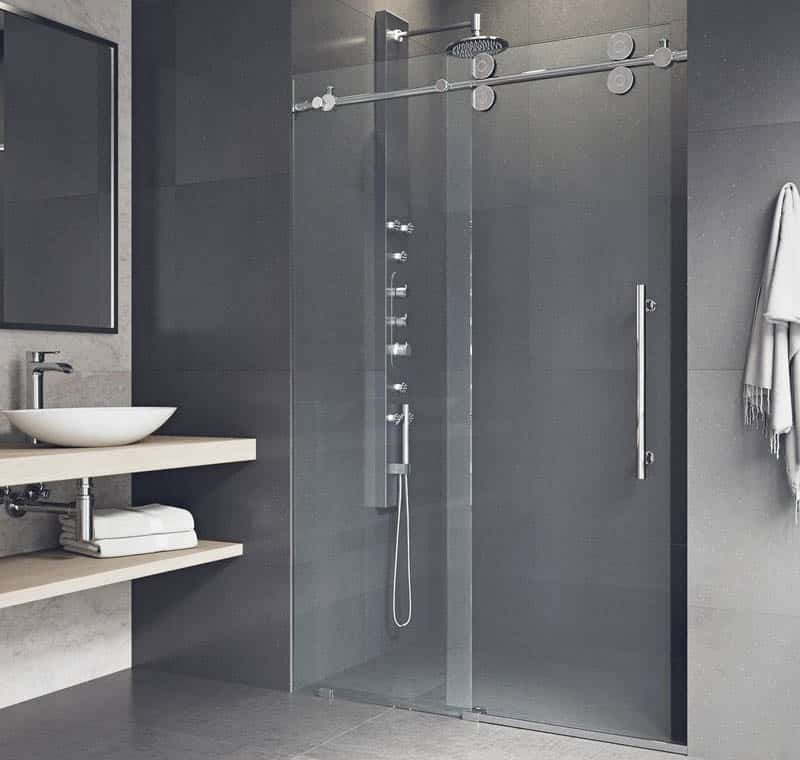
This type of door for showers is recommended for those with children or elderly users since it’s easy to open and close. Their downside is that the grooves can trap water, leading to some hard-to-reach and clean areas within the track mechanism.
Hinged Door
A hinged door is a door that is attached to the side of an enclosure’s entrance. The door rests on hinges, which means to open or shut the door; it swings out and away from the enclosure.

Hinged doors are recommended compared to sliding doors as they have fewer crevises where mold and mildew can accumulate. Another advantage is they tend to leak less overall than the sliding variety.

Care must be taken to ensure that a hinged door is attached securely and snuggly against the side of the entrance. You don’t want water seeping out or drafts creeping in. You will also need to make sure that you leave enough space around your enclosure to allow the door to swing out and open without hitting anything.
Pivot Door
A pivot door is similar to a hinged door in that both are designed to be attached to the side of the glass entrance and swing open to let you into the enclosure.
The difference between a pivot door and a hinged door is the position of the hinges. A pivot door hinges are often located at the top and bottom of the enclosure entrance. However, pivot doors can also be seen with one continuous hinge that reaches from top to bottom.

Pivot doors are popular for the clean and modern look and feel having one of these gives to your bathroom. This is also a good option if you have a small space and don’t want a sliding door.
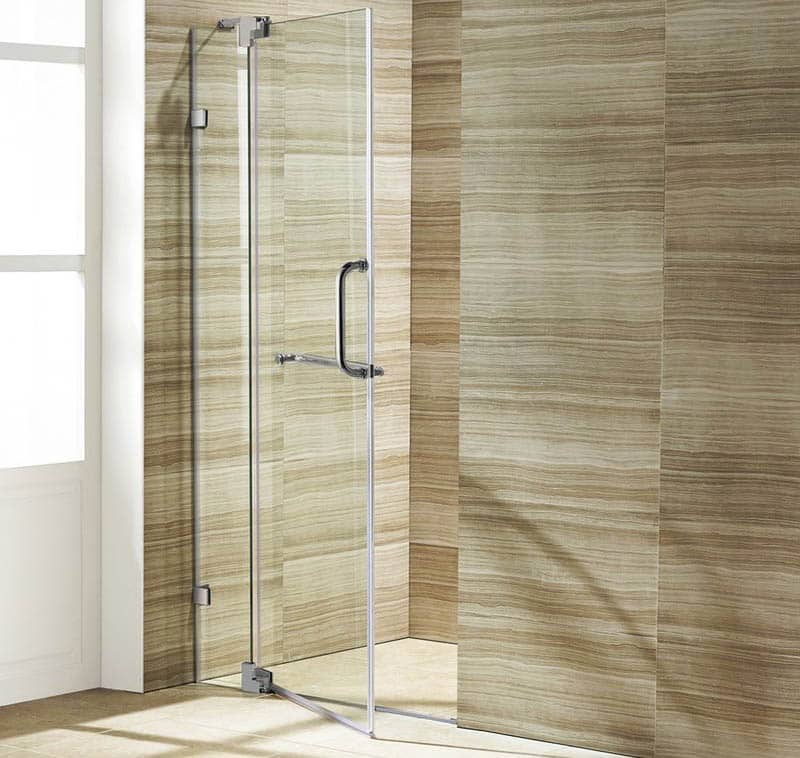
Pivot doors swing open at a smaller arc than hinge doors, so you don’t have to worry as much about hitting other bathroom fixtures.


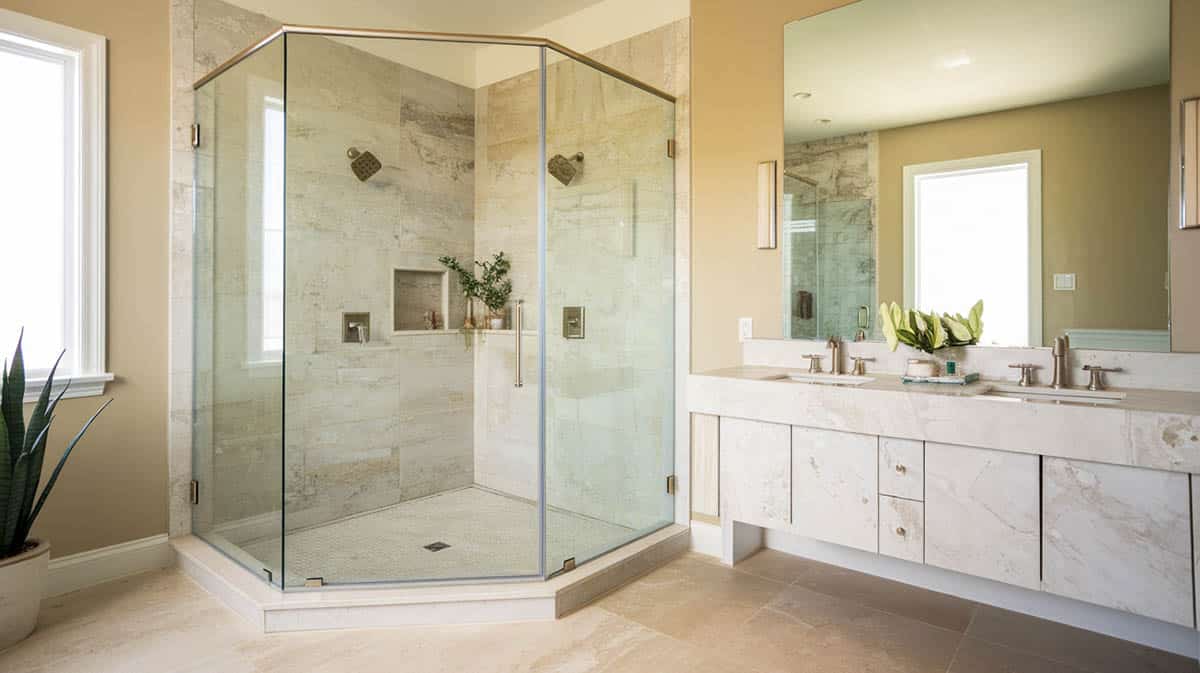




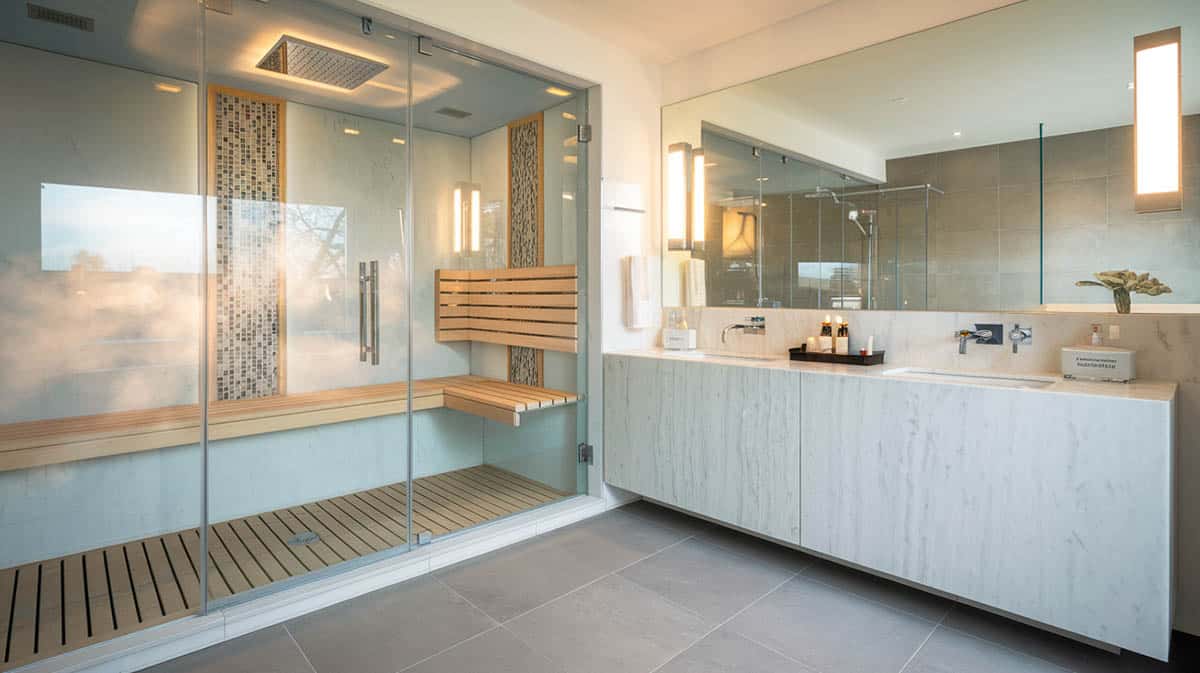






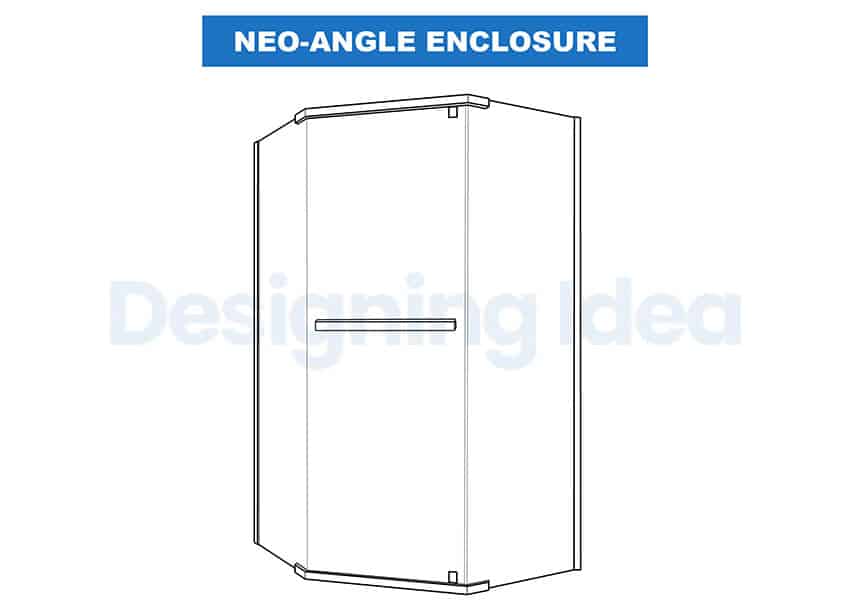
 Thermostatic Shower
Thermostatic Shower

